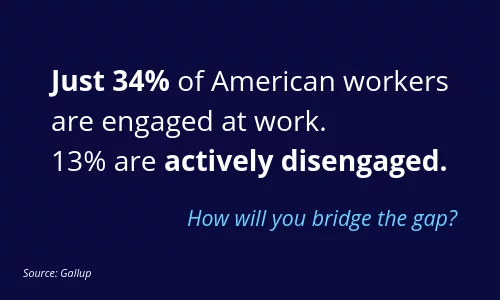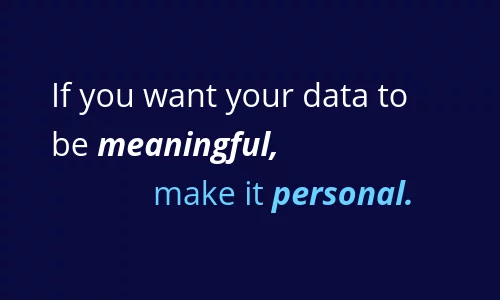Business leaders revere “the power of data” to improve the employee experience and drive better engagement. But few know how to turn these numbers into meaningful results.
When you know which raw data is valuable, you can transform it into actionable insights. With this information, it’s possible to achieve harmony between your employees and digital tools, and drive a high-performance organization.
Don’t detach your data from your people
How many times have you heard miscellaneous data points rattled off like baseball scores or exam results? It’s dull, uninspiring, and a perfect example of data communication gone wrong.
Meanwhile, the importance of high employee engagement is well known among human resources leaders and managers alike. Strong engagement safeguards retention, contributes to higher productivity, and boosts overall business performance.
Dive deeper: How to increase employee engagement and reduce turnover in the digital age
This is your opportunity to bridge the digital gap. It’s not enough to identify hard data. You must humanize big data to meet employees’ needs and foster engagement.
However, too many times, businesses fail to turn cold, hard numbers into a valuable asset for its employees. If you analyze the numbers as standalone “dry facts,” it’s easy to lose sight of the actual employees behind the data points. You’ll struggle to connect the data to informing people-centric conclusions.
- “Survey participation was strong at 90%.”
- “Engagement score was 69% but varied widely by department.”
- “Overall, engagement is trending slightly upward from 68% last year.”
- “Top driver of engagement was career development.”
- “The score is 62%, which is flat from last year.”
We often think the best way to boost performance and revenue is to hit our businesses with hard data. But data is a tool. Like any good tool, you need to know how to use it to get the best results.
At Culture Amp, we talk a lot about collecting and understanding employee feedback data.
The goal is to analyze insights in a human context — to learn to leverage the power of your existing workforce.
To use data effectively within your business (whether it’s HR/people data, customer data, or financial data), your decision makers must create a relevant connection between the numbers and your human capital.
3 key principles for humanizing your data
1. Understand your purpose for gathering new data
Outlining the purpose for gathering or sharing data is key. 
You don’t just poll your employees to discover an engagement score. The purpose of conducting an engagement survey is to identify employees’ pain points, to understand the psychology behind turnover, and to build a better work atmosphere for your team.
When you collect employee-powered data, remembering the reason why will make your insights relatable — and actionable.
2. Make the insights personal
When taking a data-driven approach, it’s essential to personalize your results. If you are interpreting or presenting data points — think about your employees.
What motivates your team? What makes them feel valued and satisfied in their roles? How can data empower employees and help them improve their productivity?
Utilize the power of data to connect, build trust between employees and management, and nurture a positive organizational culture.
3. When you’re talking to people, don’t speak in “data” — explain the story
Consider this: 4/10. It’s an isolated data point. But when leaders use storytelling, you can inspire your employees to  emotionally connect with your business’ story.
emotionally connect with your business’ story.
For instance: “If I fail to show new potential for career growth opportunities, four out of 10 employees are at risk to leave this company within the next 12 months.”
You’re using the same data point “4/10” — but to create a story that motivates action.
The objective is to keep analytics as simple as possible. When you’re sharing data, your staff needs to be able to absorb the meaning of the stats easily.
Communicate what the data points indicate to achieve buy-in from your employees. Show your team how the story impacts them and spin a narrative around the numbers.
Digital adoption is the square root of your business data sets
Data is only advantageous when you remember its driving force. It’s critical to connect your data to the human factor — the employees’ experience.
Achieving digital adoption is fundamental to bridging the gap between your digital tools and human users. Only in a state where your digital tools are being used 1) as they are designed; 2) to their fullest extent — can you build a foundation for your workforce to use all of your digital investments effectively.
When you humanize your digital workplace, you then can turn cold numbers into action — and better drive your company’s vision forward.
________
WalkMe’s Digital Adoption Platform (DAP) transforms the user experience in today’s overwhelming digital world. Using artificial intelligence, engagement, guidance, and automation, WalkMe’s transparent overlay assists users to complete tasks easily within any enterprise software, mobile application or website. Discover how a DAP can revolutionize your business — request a demo today.

